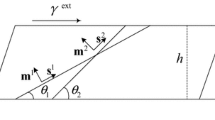Abstract
In this work the elastic field of an edge dislocation in a half-space with the effect of surface energy has been obtained. The elastic field is then used to study the image force on the dislocation, the critical thickness for dislocation generation in epitaxial thin films with strain mismatch and the yielding strength of thin films on substrates. The results show that the image forces on the dislocation deviate from the conventional solutions when the distance of the dislocation from the free surface is smaller than several times of the characteristic length. Also due to the effect of surface energy, the critical thickness for dislocation generation is smaller than that predicted by the conventional elastic solutions and the extent of the deviation depends on the magnitude of mismatch strain. In contrast, the effect of surface energy on the yielding strength for many practical thin films can be neglected except for some soft ones where the characteristic length is comparable to the thickness.
Similar content being viewed by others
References
Freund, L.B., A criterion for arrest of a threading dislocation in a strained epitaxial layer due to an interface misfit dislocation in its path. Journal of Applied Physics, 1990, 68: 2073–2080.
Houghton, D.C., strain relaxation kinetics in Si1−xGe x /Si heterostructures. Journal of Applied Physics, 1991, 70: 2136–2151.
Zhang, T.Y. and Su, Y.J., Elasticity studies of the critical thickness of an epilayer deposited on a compliant substrate. Acta Materialia, 1999, 47: 1289–1296.
Hirashita, N., Moriyama, Y., Sugiyama, N., Toyoda, E. and Takagi, S., Misfit strain relaxation in strained-Si layers on silicon-germanium-on-insulator substrates. Applied Physics Letters, 2006, 89: 091916.
Wang, S.-D., Lee, S. and Hsueh, C.-H., Effect of substrate modulus difference on dislocation formation in an epitaxial film. Mechanics of Materials, 2001, 33: 105–120.
Nix, W.G., Yielding and strain hardening of thin metal films on substrates. Scripta Materialia, 1998, 39: 545–554.
Keller-Flaig, R.M., Legros, M., Sigle, W. et al., In situ transmission electron microscopy investigation of threading dislocation motion in passivated thin aluminum films. Journal of Materials Research, 1999, 14: 4673–4676.
Kobrinsky, M.J., Dehm, G., Thompson, C.V. et al., Effects of thickness on the characteristic length scale of dislocation plasticity in Ag thin films. Acta Materialia, 2001, 49: 3597–3607.
Li, Q.Z. and Anderson, P.M., Dislocation-based modeling of the mechanical behavior of epitaxial metallic multilayer thin films. Acta Materialia, 2005, 53: 1121–1134.
Fredriksson, P. and Gudmundson, P., Size-dependent yield strength of thin films. International Journal of Plasticity, 2005, 21: 1834–1854.
Ghoniem, N.M. and Han, X., Dislocation motion in anisotropic multilayer materials. Philosophical Magazine, 2005, 85: 2809–2830.
Gruber, P.A., Bohm, J., Onuseit, F. et al., Size effects on yield strength and strain hardening for ultra-thin Cu films with and without passivation: A study by synchrotron and bulge test techniques. Acta Materialia, 2008, 56: 2318–2335.
Miller, R.E. and Shenoy, V.B., Size-dependent elastic properties of nanosized structural elements. Nanotechnology, 2000, 11: 139–147.
Cuenot, S., Fretigny, C., Demoustier-Champagne, S. and Nysten, B., Surface tension effect on the mechanical properties of nanomaterials measured by atomic force microscopy. Physical Review B, 2004, 69: 165410.
He, L.H., Lim, C.W. and Wu, B.S., A continuum model for size-dependent deformation of elastic films of nano-scale thickness. International Journal of Solids and Structures, 2004, 41: 847–857.
Duan, H.L., Wang, J., Huang, Z.P. and Karihaloo, B.L., Size-dependent effective elastic constants of solids containing nano-inhomogeneities with interface stress. Journal of Mechanics and Physics of Solids, 2005, 53: 1574–1596.
Gurtin, M.E. and Murdoch, A.I., A continuum theory of elastic material surfaces. Archive for Rational Mechanics and Analysis, 1975, 57: 291–323.
Wang, G.F. and Feng, X.Q., Effect of surface stresses on contact problems at nanoscale. Journal of Applied Physics, 2007, 101: 013510.
Author information
Authors and Affiliations
Corresponding author
Rights and permissions
About this article
Cite this article
Huang, G., Svendsen, B. & Lu, Z. Effect of Surface Energy on Dislocation-Induced Field in Half-Space with Application to Thin Film-Substrate Systems. Acta Mech. Solida Sin. 22, 436–442 (2009). https://doi.org/10.1016/S0894-9166(09)60294-9
Received:
Revised:
Published:
Issue Date:
DOI: https://doi.org/10.1016/S0894-9166(09)60294-9




